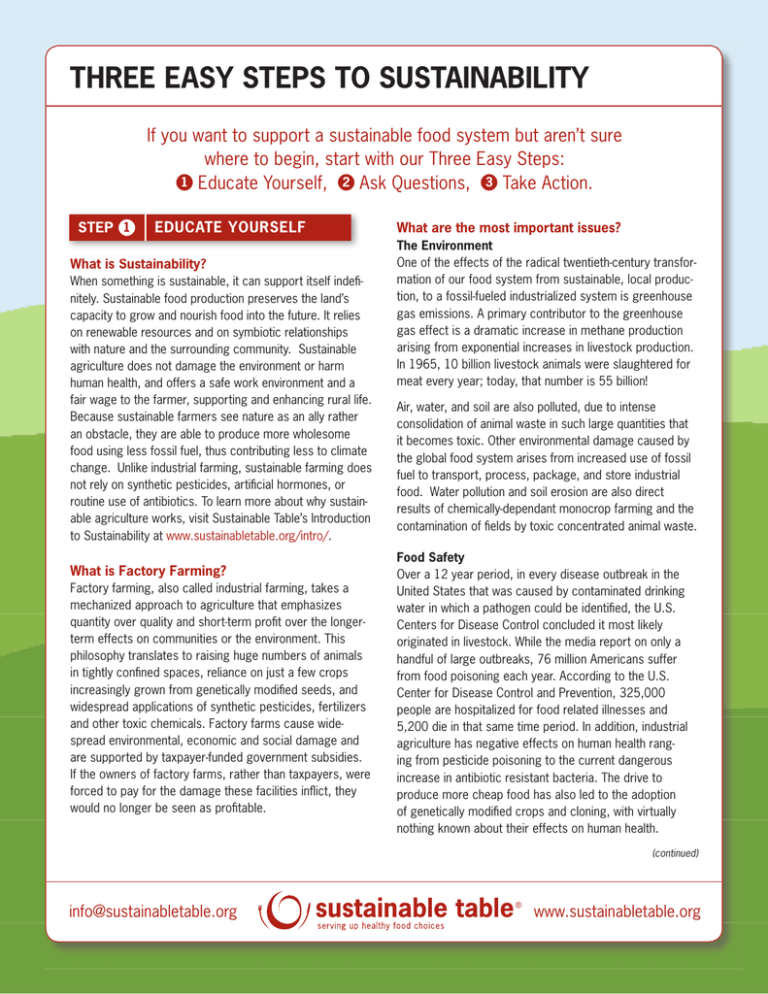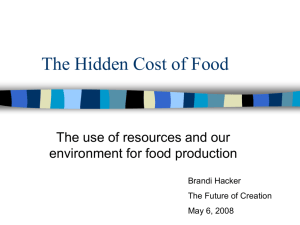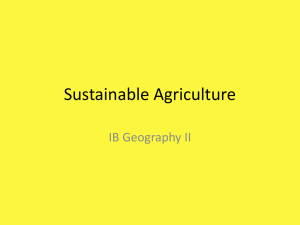Three Easy Steps to Sustainability
advertisement

THREE EASY STEPS TO SUSTAINABILITY If you want to support a sustainable food system but aren’t sure where to begin, start with our Three Easy Steps: 1 Educate Yourself, 2 Ask Questions, 3 Take Action. STEP 1 EDUCATE YOURSELF What is Sustainability? When something is sustainable, it can support itself indefinitely. Sustainable food production preserves the land’s capacity to grow and nourish food into the future. It relies on renewable resources and on symbiotic relationships with nature and the surrounding community. Sustainable agriculture does not damage the environment or harm human health, and offers a safe work environment and a fair wage to the farmer, supporting and enhancing rural life. Because sustainable farmers see nature as an ally rather an obstacle, they are able to produce more wholesome food using less fossil fuel, thus contributing less to climate change. Unlike industrial farming, sustainable farming does not rely on synthetic pesticides, artificial hormones, or routine use of antibiotics. To learn more about why sustainable agriculture works, visit Sustainable Table’s Introduction to Sustainability at www.sustainabletable.org/intro/. What is Factory Farming? Factory farming, also called industrial farming, takes a mechanized approach to agriculture that emphasizes quantity over quality and short-term profit over the longerterm effects on communities or the environment. This philosophy translates to raising huge numbers of animals in tightly confined spaces, reliance on just a few crops increasingly grown from genetically modified seeds, and widespread applications of synthetic pesticides, fertilizers and other toxic chemicals. Factory farms cause widespread environmental, economic and social damage and are supported by taxpayer-funded government subsidies. If the owners of factory farms, rather than taxpayers, were forced to pay for the damage these facilities inflict, they would no longer be seen as profitable. What are the most important issues? The Environment One of the effects of the radical twentieth-century transformation of our food system from sustainable, local production, to a fossil-fueled industrialized system is greenhouse gas emissions. A primary contributor to the greenhouse gas effect is a dramatic increase in methane production arising from exponential increases in livestock production. In 1965, 10 billion livestock animals were slaughtered for meat every year; today, that number is 55 billion! Air, water, and soil are also polluted, due to intense consolidation of animal waste in such large quantities that it becomes toxic. Other environmental damage caused by the global food system arises from increased use of fossil fuel to transport, process, package, and store industrial food. Water pollution and soil erosion are also direct results of chemically-dependant monocrop farming and the contamination of fields by toxic concentrated animal waste. Food Safety Over a 12 year period, in every disease outbreak in the United States that was caused by contaminated drinking water in which a pathogen could be identified, the U.S. Centers for Disease Control concluded it most likely originated in livestock. While the media report on only a handful of large outbreaks, 76 million Americans suffer from food poisoning each year. According to the U.S. Center for Disease Control and Prevention, 325,000 people are hospitalized for food related illnesses and 5,200 die in that same time period. In addition, industrial agriculture has negative effects on human health ranging from pesticide poisoning to the current dangerous increase in antibiotic resistant bacteria. The drive to produce more cheap food has also led to the adoption of genetically modified crops and cloning, with virtually nothing known about their effects on human health. (continued) info@sustainabletable.org ® www.sustainabletable.org THREE EASY STEPS TO SUSTAINABILITY (cont’d) Ethics Workers on industrial farms suffer dangerous working conditions, and significant health risks. Meanwhile, studies show that communities surrounding factory farms suffer increased crime rates, violence, decreased property values, weakened economies, and social unrest. The basic structure of industrial livestock production is fundamentally at odds with the welfare of the animals it produces and the workers it employs. Indoors, in confinement, given feed their bodies were not designed to digest supplemented by synthetic fillers, growth hormones and non-therapeutic antibiotics, factory farm animals cannot exhibit basic natural behaviors like turning around, lying down, foraging or socializing. STEP 2 ASK QUESTIONS It is your right as a consumer to know how the food you eat was produced. Asking simple questions like: “Do you sell locally raised or sustainably raised products?” or “Did this meat come from cows raised on grass?” can go a long way toward helping you understand where your food comes from. Use Sustainable Table’s Questions to Ask section and go equipped to the farm, store or restaurant to really find out about what you’re eating. You can print out “Questions to Ask” to take with you so that you’ll be ready to learn about your food. You can find the questions at www.sustainabletable.org/spread/handouts/. STEP 3 TAKE ACTION Buy Local, Buy Direct Sustainability includes buying food as locally as possible. Organizations all over the country are working to create local food networks and to help consumers identify local and sustainable products in the marketplace. There are many opportunities to buy food directly from local farms through farmers’ markets or community supported agriculture (CSA) groups. Learn more about these options at www.sustainabletable.org/shop/. Grow Your Own Growing even a little of your own food will teach you a lot about what it takes to be a farmer and you may well end up with the most local in-season produce possible. Whether it’s a backyard garden, community plot or windowsill planter, just about everyone can grow something, no matter how small their space. To get started visit www.sustainabletable.org/issues/growyourown. Learn More There are many important issues that farmers and consumers alike face given our current global industrial food system. Please take the time to educate yourself at www.sustainabletable.org/issues. Get Involved Demand for a sustainable food system is a growing movement. Invite your friends and neighbors over for sustainable dinners, start a sustainable book club or plant a garden. Visit our Get Involved section for more ideas at www.sustainabletable.org/getinvolved. Using these three steps, you can help build or strengthen your local food system. To learn more visit Sustainable Table’s Eat Local, Buy Local, Be Local feature at www.sustainabletable.org/issues/eatlocal/. info@sustainabletable.org ® www.sustainabletable.org


